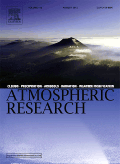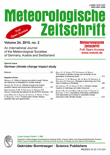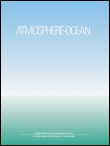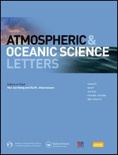
Mausam
Scope & Guideline
Advancing Atmospheric Insights with Mausam
Introduction
Aims and Scopes
- Meteorological Research and Forecasting:
The journal emphasizes the analysis and prediction of weather patterns using various models, including numerical weather prediction and machine learning approaches. - Climate Change and Variability Studies:
Research on climate change impacts, including temperature and precipitation trends, and their effects on agriculture, ecosystems, and water resources is a core focus. - Remote Sensing Applications:
Utilization of satellite data for weather monitoring, rainfall estimation, and land surface temperature analysis is a significant methodological approach. - Agricultural Meteorology:
The journal publishes studies that assess the impact of weather and climate on crop yields, irrigation scheduling, and agro-advisory services. - Natural Disaster Analysis:
Research on the dynamics of extreme weather events such as cyclones, floods, and droughts, including their forecasting and risk assessment, is prominently featured. - Statistical Methods and Modeling:
The application of statistical techniques for analyzing weather data, including trend analysis and probability distributions, is a key area of research. - Environmental and Public Health Impacts:
Studies on air quality, pollution, and their links to meteorological conditions reflect a growing interest in the intersection of climate science and public health.
Trending and Emerging
- Machine Learning in Weather Prediction:
There is a growing trend of utilizing machine learning algorithms for weather forecasting and rainfall prediction, showcasing the journal's embrace of cutting-edge technology. - Impact of Climate Change on Agriculture:
Research focusing on how climate change affects agricultural productivity is becoming increasingly prominent, reflecting the urgent need to address food security in a changing climate. - Integration of Remote Sensing and GIS:
The incorporation of remote sensing data and Geographic Information Systems (GIS) in studies related to weather and climate is on the rise, facilitating more comprehensive analyses. - Extreme Weather Events and Disaster Risk Management:
The frequency of studies addressing extreme weather events and their socio-economic impacts indicates a heightened awareness of disaster preparedness and resilience. - Air Quality and Meteorological Interactions:
Emerging studies linking air quality with meteorological factors highlight an increasing focus on environmental health and public policy implications. - Hydrological Modeling and Water Resource Management:
Research in hydrological modeling, particularly in the context of climate variability and its effects on water resources, is gaining traction, indicating a broader environmental focus. - Urban Meteorology and Climate Adaptation:
The exploration of urban meteorology, including the effects of climate change on urban areas and adaptation strategies, is an emerging theme reflecting global urbanization challenges.
Declining or Waning
- Traditional Weather Observation Techniques:
The reliance on conventional weather observation methods seems to be diminishing as newer technologies and models gain traction, leading to fewer studies focusing solely on these methods. - Historical Climate Reconstructions:
There appears to be a waning interest in purely historical climate reconstructions, with more emphasis now placed on real-time data analysis and predictive modeling. - Geographic Specificity:
Research that is narrowly focused on specific geographic regions without broader implications or applications is becoming less frequent, as there is a trend towards studies with wider applicability. - Basic Climate Modeling:
Basic climate modeling studies, which do not incorporate advanced techniques or interdisciplinary approaches, are increasingly overshadowed by more complex analyses that integrate multiple data sources and methodologies. - Case Studies of Local Weather Events:
While case studies remain important, there is a noticeable shift towards larger-scale analyses and modeling efforts that encompass broader geographic and temporal scales.
Similar Journals

Atmospheric Science Letters
Advancing knowledge in atmospheric science.Atmospheric Science Letters, published by WILEY, is a leading open-access journal in the field of Atmospheric Science. Since its establishment in 2000, it has significantly contributed to advancing knowledge related to the Earth's atmosphere, focusing on both theoretical and practical aspects. With an impressive Q2 ranking in the Atmosphere Science category as of 2023 and a Scopus rank of 62 out of 148, this journal provides a platform for researchers and professionals to share their findings and insights. The journal’s commitment to open access since 2016 ensures that cutting-edge research is accessible to a global audience, fostering collaboration and innovation in the atmospheric sciences. Addressed from its headquarters at 111 River St, Hoboken, NJ, USA, Atmospheric Science Letters is pivotal for students, researchers, and professionals seeking to stay abreast of the latest developments in this dynamic field.

Atmospheric Research
Exploring the Dynamics of Our AtmosphereAtmospheric Research is a premier journal published by Elsevier Science Inc, specializing in the field of Atmospheric Science. With a commendable impact factor, it holds a distinguished position in the Scopus rankings, being placed 14th out of 148 journals within its category and achieving a remarkable 90th percentile rank. This journal serves as a vital outlet for rigorous research on atmospheric processes, climate variability, and meteorological phenomena, providing a platform for scientists, researchers, and students to disseminate their findings and contribute to the advancement of knowledge in this critical field. Although it is not an open-access journal, its strong reputation and selective publication criteria ensure that only high-quality and impactful studies are featured. Since its inception in 1986, Atmospheric Research has continuously evolved to meet the dynamic nature of atmospheric studies, making it a fundamental resource for anyone engaged in understanding and addressing atmospheric challenges worldwide.

Weather and Climate Dynamics
Championing Open Access to Climate ScienceWeather and Climate Dynamics, an esteemed journal published by COPERNICUS GESELLSCHAFT MBH, focuses on the intricate relationships and processes governing climate and weather patterns, advancing our understanding of atmospheric sciences. Since its launch in 2020, this Open Access journal has rapidly gained recognition, achieving a commendable Q1 status in Atmospheric Science and ranking 39th out of 148 journals in the Earth and Planetary Sciences category, placing it in the 73rd percentile. Based in Germany, the journal aims to provide a platform for innovative research, sharing crucial findings that contribute to tackling global climate challenges. Researchers, professionals, and students alike are encouraged to explore the wealth of knowledge contained within its pages, as it continues to shape the discourse on weather and climate dynamics through rigorous and impactful scholarship.

Weather and Climate
Innovating Solutions for a Changing WorldWeather and Climate is a prestigious, peer-reviewed journal published by the Meteorological Society of New Zealand, dedicated to advancing knowledge in the domains of meteorology and climatology. With the ISSN 0111-5499, the journal serves as a vital platform for researchers and professionals to disseminate impactful findings that address pressing issues related to weather patterns and climate change. Although it does not operate on an open-access model, it provides a wealth of valuable insights drawn from a diverse range of studies. The significance of this journal in the scientific community is underscored by its commitment to fostering interdisciplinary collaboration and sharing innovative research that can inform policy-making and environmental management strategies. Located in Wellington, New Zealand, Weather and Climate not only contributes to regional meteorological discourse but also holds relevance for the global scientific landscape, making it essential reading for anyone invested in the future of our changing climate.

METEOROLOGISCHE ZEITSCHRIFT
Charting New Territories in Meteorological StudiesMETEOROLOGISCHE ZEITSCHRIFT is a distinguished academic journal dedicated to the field of meteorology and atmospheric sciences, published by E SCHWEIZERBARTSCHE VERLAGSBUCHHANDLUNG. With an ISSN of 0941-2948 and an E-ISSN of 1610-1227, this journal has been an invaluable resource for researchers, professionals, and students since its inception. It has embraced an Open Access model since 2014, promoting wider dissemination of research findings. Based in Stuttgart, Germany, the journal is recognized for its rigorous peer-review process and is currently positioned in the Q3 quartile for Atmospheric Science as per the 2023 category rankings. Additionally, it ranks #97 out of 148 in the Scopus database, placing it in the 34th percentile among Earth and Planetary Sciences. Covering a broad spectrum of topics relevant to meteorology, METEOROLOGISCHE ZEITSCHRIFT serves as a platform for innovative research and theoretical contributions, aiming to advance understanding of atmospheric phenomena and their implications for climate and weather. Researchers and practitioners alike will find valuable insights within its pages, making it a significant asset in the landscape of meteorological scholarship.

ATMOSPHERE-OCEAN
Bridging the Gap Between Oceanography and Atmospheric ScienceATMOSPHERE-OCEAN is a premier peer-reviewed journal published by Taylor & Francis Ltd, dedicated to advancing the fields of atmospheric science and oceanography. Since its inception in 1963, this journal has served as a crucial platform for researchers, professionals, and students, facilitating the dissemination of significant findings and innovative methodologies in understanding the complex interactions between the atmosphere and the ocean. With its journal ranking in the Q3 category for Atmospheric Science and Q2 for Oceanography as of 2023, along with its Scopus rankings, ATMOSPHERE-OCEAN maintains its relevance by addressing current topics such as climate change, hydrology, and ocean circulation patterns. For those seeking to contribute to or stay informed about the latest research in these critical fields, ATMOSPHERE-OCEAN is an invaluable resource that combines rigorous scholarship with practical implications for environmental management and policy.

Atmospheric and Oceanic Science Letters
Bridging the Gap Between Atmosphere and OceanAtmospheric and Oceanic Science Letters is a premier open-access journal dedicated to the rapidly evolving fields of atmospheric science and oceanography. Published by KEAI PUBLISHING LTD, this journal aims to foster research dissemination and collaboration by providing a platform for high-quality research articles, reviews, and case studies that address critical issues impacting atmospheric and oceanic systems. With an impressive impact factor reflecting its esteemed position—including being ranked Q2 in Atmospheric Science and Q1 in Oceanography in 2023—this journal is an essential resource for researchers, professionals, and students alike. The journal's Open Access model, adopted since 2016, ensures that groundbreaking research is readily available to a global audience, enhancing knowledge transfer and facilitating innovative solutions to environmental challenges. Operating out of the United Kingdom and reaching an international readership, Atmospheric and Oceanic Science Letters plays a pivotal role in shaping our understanding of the interactions between the atmosphere and oceans, making it a vital publication for anyone aiming to stay at the forefront of these dynamic scientific fields.

ADVANCES IN ATMOSPHERIC SCIENCES
Fostering Innovation in Meteorological StudiesADVANCES IN ATMOSPHERIC SCIENCES is a highly esteemed journal published by SCIENCE PRESS, dedicated to advancing the field of atmospheric sciences. With an impressive impact factor and ranking as Q1 in Atmospheric Science as of 2023, this journal serves as a leading platform for researchers, professionals, and students to disseminate substantial findings and innovative methodologies across various topics within the atmospheric sciences domain. Established in 1984 and continuously publishing through to 2024, it has successfully positioned itself among the top ranks, currently standing at #17 out of 148 in the Scopus category, highlighting its significance in the field with a remarkable 88th percentile. Although it operates under traditional access, the journal provides invaluable insights into climate dynamics, meteorology, and environmental processes that are crucial for both academic and practical applications. Based in Beijing, China, ADVANCES IN ATMOSPHERIC SCIENCES is committed to fostering a global dialogue and collaboration among scholars and industry experts, making it an essential resource for those invested in understanding and addressing contemporary atmospheric challenges.

Tethys-Journal of Mediterranean Meteorology & Climatology
Advancing Knowledge of Mediterranean Weather PatternsTethys - Journal of Mediterranean Meteorology & Climatology, published by the Associació Catalana de Meteorologia (ACAM), serves as a specialized platform dedicated to advancing the study of meteorological and climatological phenomena within the Mediterranean region. With a Scopus Rank of #94 out of 148 in the field of Atmospheric Science, this journal is positioned in the Q4 category, reflecting a growing recognition among researchers focused on regional climate variations and environmental challenges. Established in 2012 and publishing through 2023, Tethys aims to provide open access to high-quality research articles that address critical issues impacting climate and weather patterns, thus contributing to a deeper understanding of Mediterranean meteorology. The journal’s mission aligns closely with the increasing global emphasis on climate studies and serves as an essential resource for academics, practitioners, and students dedicated to sustainably addressing the environmental and climatic challenges faced by this diverse and dynamic region.

METEOROLOGY AND ATMOSPHERIC PHYSICS
Charting New Territories in Atmospheric PhysicsMETEOROLOGY AND ATMOSPHERIC PHYSICS is a premier journal published by SPRINGER WIEN, dedicated to advancing the study of atmospheric phenomena and weather-related sciences. With an ISSN of 0177-7971 and an E-ISSN of 1436-5065, the journal has established itself as an important contributor in the field, particularly noted for its contributions in atmospheric science, holding a Q3 ranking in the 2023 category quartiles. Covering a wide array of topics from meteorological modeling to the physics of the atmosphere, it serves researchers, professionals, and students alike, facilitating the dissemination of significant findings and innovative research. The journal’s acceptance of articles until 2024 encourages a continuous influx of knowledge, and despite its lack of Open Access, it plays a crucial role in enriching the academic landscape for those engaged in Earth and planetary sciences, holding a commendable rank of 78 out of 148 in Scopus. Located in the scenic city of Vienna, Austria, the journal is positioned to harness the vibrancy of the academic community, providing a platform for valuable insights that can drive forward the field of meteorology and atmospheric physics.